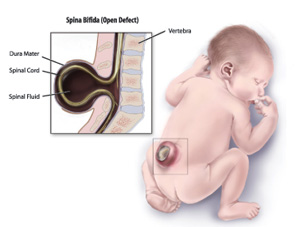Pregnancy is the most natural process that a woman’s body goes through, which results in the miracle of birth. But this is not without risks to the mother and the unborn child. Spina bifida literally means a ‘split spine’ and is caused by the abnormal formation of one or more of the bones which form the spine, the vertebral bodies. This occurs in early pregnancy and may leave the important nerves that travel within the bony structures to be unprotected leading to damage.
Recent evidence suggests that there may be environmental and genetic factors playing a part in this condition. But what we do know is that taking a daily folic acid supplement from at least one month before conception through to the end of the 12th week of pregnancy can reduce the risk of Spina Bifida by up to 70 percent. Eating well with foods containing folic acid is also beneficial.
Foods containing folic acid
- Fortified breakfast cereals
- Green leafy vegetables
- Peas and chickpeas
- Oranges
- Baked beans
What are the types of
Spina Bifida?
There are mainly two types, Spina bifida occulta and Spina
bifida aperta.
Spina Bifida Occulta:
One in ten people are thought to have this condition. Most people don’t even know that they have it and maybe diagnosed incidentally, when investigated for other conditions. The patients may have external signs in the back, such as tufts of hair, skin dimples. Treatment is usually not required.
Spina Bifida Aperta:
This is when contents of the spinal cord such as nerves can protrude out of the bony abnormalities. This can be very severe when the contents are exposed to the outside, (called a myelomeningocele) or milder when they are still enclosed within a ‘sac’, thin layer of skin (meningocele).
In most instances myelomeningoceles have a worse outcome. Those affected will be left with paralysis and sensory loss below the level that is affected. There will be bladder and bowel problems.
In those with meningoceles, there may also be symptoms that may arise later on in life such as walking difficulties, back pain, and incontinence.
Both are diagnosed when a child is born at their first check but may also be picked up at prenatal scans. The main aim at birth is to protect the contents exposed so further damage doesn’t occur.
This is carried out by performing an operation. The operation involves removing the damaged areas and covering the defective area with the child’s own skin. The operation is carried out in the first few hours if not days of the child’s life.
These children will require continuous help throughout their life. Help and support will be required for the child and family.
The children may also have other developmental problems that may need to be addressed. But with help and support they can go on to lead happy and fulfilling lives. |


